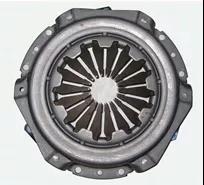The Efficient Data Solution of clutch: The synergy of 3D scanning and UG
In the process of driving a car, including starting, shifting, decelerating, and braking, many green drivers have been in a hurry because of the inability to operate the clutch.
The clutch is installed between the engine and the transmission, and plays a very important role in transmission, vibration reduction and preventing system from overloading. The driver can step on or release the clutch pedal, which makes the engine and the transmission temporarily separate or gradually meet, so as to cut off or transmit the power.
In recent years, with the advancement of automobile technology and the improvement of driving speed, the higher requirements have been on the technical level and product quality of clutch manufacturers.
Then efficiency determines the production capacity. In recent fierce market competition, if manufacturers want to stand out, they must highly output since they get the orders.
Customer demand
The customer is a clutch manufacturer, and its partners need to reverse design, process and produce a clutch, but they only have a prototype of the clutch, and they don’t have any relevant data and drawings.
In order to win the order, the customer needs to quickly come up with the 3D data plan of the clutch. After the purchaser is satisfied and the order is completed, they can continue to do refined reverse design and guide processing.
Conventional solution
The conventional method of enterprises is to use traditional measurement methods, such as calipers, micrometers, three-coordinates, profilers, imagers and other equipment, to measure the entire clutch and the individual parts which was disassembled, and then make a three-dimensional model based on the measurement data to show to customers.
This process roughly takes a week or even longer, which is time-consuming and laborious. If the order fails to be completed in the end, it will be a great waste to the cost of the enterprise.
Solution
The ZG-3DTechnology-RigelScan Plus is used to efficiently scan the parts of the clutch to obtain accurate 3D data, and the data is directly imported into the UG software for three-dimensional assembly. Finally, output the exploded drawing and display to customers.
From scanning to outputting the exploded drawing, the whole process only takes half a day.
Actual steps
------1 Scanning preparation------
Due to the selection of thinner pressure plate, diaphragm spring, clutch cover, and driving strap whose edge thickness are 6mm, 2.5mm, 4, 1.5mm respectively, it is necessary to borrow the desktop marking point to identify the terminal positioning point, and then perform the standard scan.
------2 Parameter setting------
For the specification of clutch, the resolution is 0.3mm.。
------3 Scanning and UG assembly------
Using RigelScan Plus to scan the whole one individually, and the scanning time was in about 1 hour, and finally get four 3D models.
▲The data of the pressure plate
▲The data of the diaphragm spring
▲The data of the steel sheet of gearbox
Import the scanning data into UG for position assembly, and make diagrams on schedule.

▲The video of exploded drawing
Summary
The ZG-3DTechnology solution compares the optimization solution, and its high efficiency makes customers very amazed! Quickly display the exploded drawing, which helps customers to obtain orders.
At the same time, after the order consultation, they can continue to use the scanned data for refined processing and follow-up design. The final design can also be processed, and the manufactured products can be inspected for quality.
It can be said that the combination of RigelScan Plus and UG software generates the full life cycle of the product, which helps customers greatly improve efficiency, enhance work intensity, save time and the cost of manpower and material, and bring benefits to the enterprise.